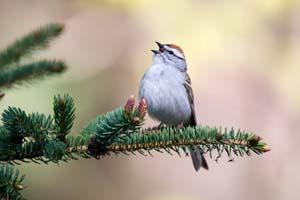Fun Facts About Native Sparrows
Though native sparrows appear to look alike, these regular feeder visitors have distinct differences. Native sparrows nest on the ground & in bushes or trees. Native sparrows will not use a nest box and are not to be confused with the European House Sparrow which does nest in nest boxes.
What Foods Do Native Sparrows Eat? White Millet, oil sunflower, sunflower chips, cracked corn, peanut pieces, Bark Butter®, Bark Butter Bits
Chipping Sparrows must consume over two pounds of seeds through the course of winter to survive. With an average body weight of only 13 grams, this means that Chipping Sparrows consume over 70 times their own weight in seeds each winter.
Most birds molt all of their body feathers once or twice a year. Chipping Sparrows follow the same schedule and they may also replace the feathers on its face and throat up to six times a year.
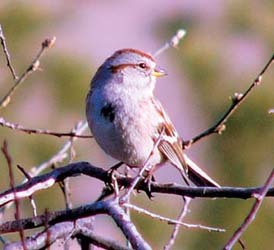
American Tree Sparrows are known to eat large amounts of common weed seeds. Each year they are estimated to eat 875 tons of the weed seeds in the state Iowa alone.
When the ground is snow covered, American Tree Sparrows have been observed to fly around a weed plant, using their wings to dislodge its seeds onto the snow below for easy retrieval.
An American Tree Sparrow eats about 30% of its own body weight in food every day during the summer. They also drink about 30% of their own body weight of water each day.
Which is your dominant eye? American Tree Sparrows seem to prefer to look for predators out of their left eye.
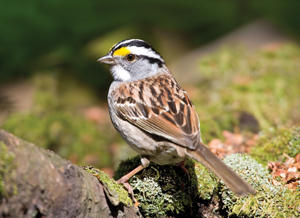 Individual White-throated Sparrows have either white stripes on their head or tan stripes. These distinct color forms are genetic in origin. White-striped birds are more aggressive than tan-striped ones, and each bird almost always mates with a bird whose stripe color is opposite from their own.
Individual White-throated Sparrows have either white stripes on their head or tan stripes. These distinct color forms are genetic in origin. White-striped birds are more aggressive than tan-striped ones, and each bird almost always mates with a bird whose stripe color is opposite from their own.
White-throated Sparrows and the Dark-eyed Juncos have been known to occasionally mate and produce hybrids.
White-throated Sparrows readily visit feeders or peck at fallen seeds beneath them. They feed on millet as well as sunflower seeds. If you make a brush pile in your yard it will give White-throated Sparrows a place to take cover in between trips out into your yard to feed. In winter these birds often forage in large flocks

White-crowned Sparrows have been known to migrate over 2600 miles from Alaska to California. While migrating north in the spring, their average travel distance is about 70 miles per day.
They show loyalty to their winter territories and are likely to return to the same areas each year.
Male White-crowned Sparrows do most of the singing, but sometimes females also sing. They usually do this while contesting breeding territories or a winter food source. Their songs are quieter and more variable than male’s songs.
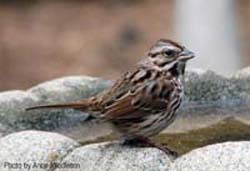
Song Sparrows are the most common and widespread sparrow native to North America. There are 31 recognized subspecies of the Song Sparrow, more than any other bird species found in North America.
When migrating, female Song Sparrows travel farther south than do their male counterparts. A pair of Song Sparrows will live and nest in 1-1/2 acres or fewer and may raise up to four broods a year.
They will forage for food on the ground by using a double-scratch technique of kicking away debris by hopping forward while sweeping both feet quickly back along the ground.
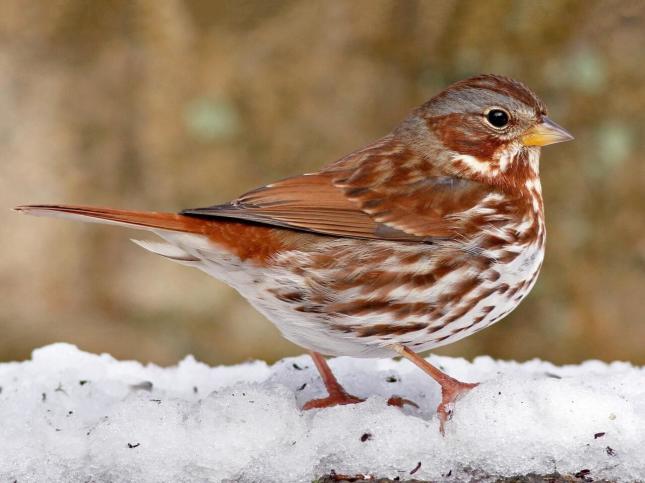 Fox Sparrows are typically seen sending up a spray of leaf litter as they kick around in search of food. Encouraging shrubs or berry bushes to grow at the edges of your yard, or keeping a brush pile, are good ways to provide places for Fox Sparrows to forage.
Fox Sparrows are typically seen sending up a spray of leaf litter as they kick around in search of food. Encouraging shrubs or berry bushes to grow at the edges of your yard, or keeping a brush pile, are good ways to provide places for Fox Sparrows to forage.
Fox Sparrows are dark, splotchy sparrows of dense thickets. Named for the rich red hues that many Fox Sparrows wear, this species is nevertheless one of our most variable birds, with four main groups that can range from foxy red to gray to dark brown.
Since they breed primarily in remote areas, many people see them in winter when the birds move into backyard thickets.
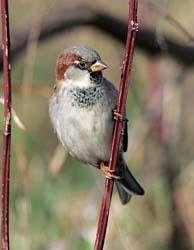
European House Sparrows are NOT native North American sparrows. House Sparrows were originally native to Eurasia and North Africa, they have successfully followed man to all of the world’s continents except Antarctica.
The House Sparrow was introduced into Brooklyn, New York, in 1851. By 1900 it had spread to the Rocky Mountains. Two more introductions in the early 1870s, in San Francisco and Salt Lake City, aided the bird’s spread throughout the West. House Sparrows are now common across all of North America except Alaska and far northern Canada.
As a non-native species, it is not included on the 2016 State of the Birds Report. Many people regard House Sparrows as undesirables in their yards, since they aren't native and can be a menace to native species. House Sparrows are so closely entwined with people's lives that you probably will find them around your home even without feeding them.
House Sparrows nest in holes of buildings and other structures such as streetlights, gas-station roofs, signs, and the overhanging fixtures that hold traffic lights. They sometimes build nests in vines climbing the walls of buildings. House Sparrows are strong competitors for nest boxes, too, at times displacing the species the nest box was intended for, such as bluebirds and Tree Swallows.


